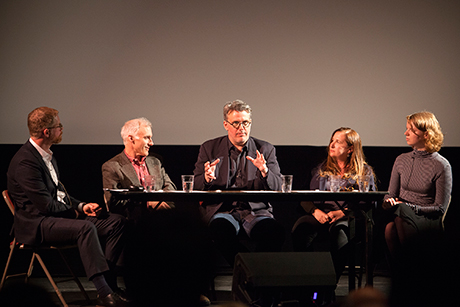Moviemakers say it is still all about the story
By Kathy Hovis

As a panel of Cornell alumni filmmakers talked about the pros and cons of the latest technologies during a Charter Day Weekend event April 25, Austin Bunn, assistant professor of performing and media arts, quipped: “How many frames per second is the speed of life?”
Producer Scott Ferguson ’83, editor Tim Squyres ’81 and filmmaker Tia Lessin ’86 shared stories of making 16 mm films as undergrads, innovations in filmmaking and the benefits of a broad education.
“A liberal arts education is very helpful because it gives you something interesting to say,” said Squyres, who showed clips from the making of “Life of Pi” that highlighted how moviemakers created the scene of a sinking cargo ship full of zoo animals. “It really comes down to your storytelling skills.”
Lessin said her time at Cornell, during the South African divestment campaigns of the 1980s, taught her to think critically and ask hard questions of people in power, skills she uses today as a documentary filmmaker. Her recent work, “Trouble the Water,” won an Academy Award.
Ferguson entered Cornell to study engineering, but film classes revealed his real interest. “I tell students to keep their minds open because you never know what fascinating thing you’ll come upon,” he said. He showed a clip from “Disconnect,” his recent film focused on the perils of online relationships, starring Jason Bateman and Hope Davis.
All three remarked on the changing nature of filmmaking in a world where everyone with an iPhone can create a decent video and those with handheld cameras can do even better. “Fictional narratives are adopting some ideas from handhelds and vice versa,” Lessin said.
But technology is moving filmmaking into new areas. Squyres said his newest work is being shot at 120 frames per second, while nearly every movie out today uses only 24 frames per second with the exception of “The Hobbit,” which shot at 48 frames per second to mixed reviews. Panelists wondered whether audiences will notice the difference or just be bothered by the more realistic look of movies filmed at the new rates.
Filmmakers also are making changes to accommodate audiences calling for abbreviated storytelling, Squyres said. Editors now routinely cut out shots where characters enter and exit rooms – called shoe leather, he said – because audiences want more action. They want characters who can multitask, talking while they’re walking.
Today’s audiences are drawn to movies “based on a true story,” Bunn said, citing a number of best picture nominees. But Squyres said audiences need to realize there are lots of liberties taken with that true story. “There’s a tacit understanding, or should be, between the filmmaker and the audience about why they’re watching,” Squyres said. “It might be based on a story, but it’s not anywhere near the whole story. Narrative films should not be anyone’s source of history.”
For documentary filmmakers like Lessin, rigor and accuracy are more important, but films are still works of art and need to remain that way to attract audiences.
All three filmmakers had fond memories of days and nights spent in Cornell Cinema watching life-changing movies like “McCabe and Mrs. Miller” and “Hiroshima Mon Amour,” Ferguson said.
“Cornell Cinema was the thing you did to get your fix,” he said. “I found that cinema could be positive and powerful in ways I wasn’t used to seeing.”
Kathy Hovis is a writer for the College of Arts and Sciences.
Media Contact
Get Cornell news delivered right to your inbox.
Subscribe